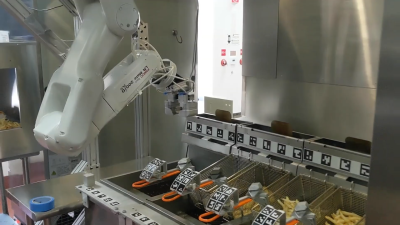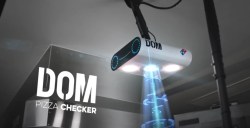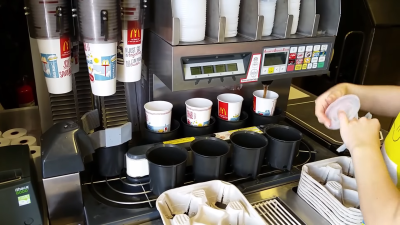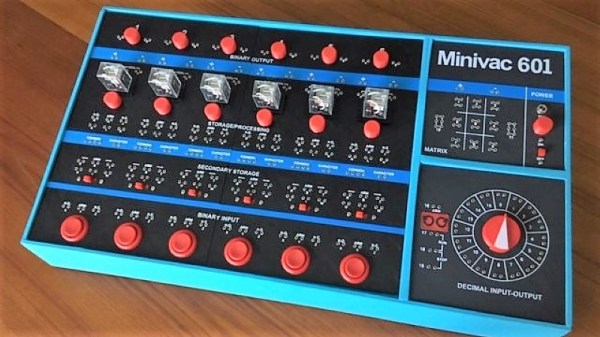Last weekend, DEF CON held their “SAFE MODE” conference: instead of meeting at a physical venue, the entire conference was held online. All the presentations are available on the official DEF CON YouTube channel. We’ll cover a few of the presentations here, and watch out for other articles on HaD with details on the other talks that we found interesting.
Continue reading “This Week In Security: DEF CON, Intel Leaks, Snapdragon, And A Robot Possessed”
Hackaday Columns4565 Articles
This excellent content from the Hackaday writing crew highlights recurring topics and popular series like Linux-Fu, 3D-Printering, Hackaday Links, This Week in Security, Inputs of Interest, Profiles in Science, Retrotechtacular, Ask Hackaday, Teardowns, Reviews, and many more.
A Tetraquark For Muster Mark!
The holy grail of every particle physics experiment is the discovery of a new particle. Finding a new constituent of matter may earn you eternal glory within the history of physics. Unfortunately, since the last missing piece of the Standard Model, the Higgs boson, was discovered in 2012, and with still no clue about the nature of dark matter and dark energy, there is not much hope to stumble upon a new fundamental building block of matter any time soon.
Luckily, this is not true for composite particles, especially the strange world of quark matter still yields some potential for new discoveries. The latest of such was the observation of a new tetraquark by the LHCb experiment. But what the hell is a quark anyway and why is it named after a German dairy product? Continue reading “A Tetraquark For Muster Mark!”
The Ever-Accelerating Automation Of Fast Food
In the fast food industry, speed is everything. The concept has never just been about cooking quickly. Players in this competitive space spend huge fortunes every year on optimizing every aspect of the experience, from ordering, to queueing, to cleaning up afterwards. And while fast food restaurants are major employers worldwide, there’s always been a firm eye cast over the gains that automation has to offer.
Flipping Burgers
In the West, fast food most commonly brings burgers to mind. Preparing a quality burger requires attention to the grade of meat, fat content, as well as the preparation steps before it hits the grill. Then it’s all about temperature and time, and getting just the right sear to bring out the natural flavors of the beef. While a boutique burger joint will employ a skilled worker to get things just right, that doesn’t fly for fast food. Every order needs to be preparable by whichever minimum-wage worker got the shift, and be as repeatable as possible across entire countries, or even the world, to meet customer expectations.

In their efforts to improve efficiency, White Castle have taken the bold step of installing a robotic burger flipper, imaginitively named Flippy. Built by Miso Robotics, the robot hangs from a ceiling rail to minimise the space taken up in the kitchen area. Based on a Fanuc robot arm, the system uses artificial intelligence to manage kitchen resources, Flippy is capable of managing both the grill and fryers together to ensure fries don’t get cold while the burgers are still cooking, for example. Currently undergoing a trial run in Chicago, White Castle has ambitions to roll the technology out to further stores if successful.
We’ve seen other robotic burger systems before, too. In late 2018, our own [Brian Benchoff] went down to check out Creator, which cooks and assembles its burgers entirely by machine. Despite suspicions about the business model, Creator have persisted until the present day with their unique blend of technology and culinary arts. Particularly impressive were their restaurant modifications in the face of COVID-19. The restaurant received an overhaul, with meals being robotically prepared directly in a take-out box with no human contact. Take-out meals are double-bagged and passed to customers through an airlock, with a positive-pressure system in the restaurant to protect staff from the outside world.
Pizzabots
Pizza is a staple food for many, with high demand and a stronger dependence on delivery than other fast food options. This has led to the industry exploring many avenues for automation, from preparation to order fulfillment.
In terms of outright throughput, Zume were a startup that led the charge. Their system involves multiple robots to knead dough, apply sauce and place the pie in the oven. Due to the variable nature sizes and shapes of various toppings, these are still applied by humans in the loop. Capable of turning out 120 pizzas per hour, a single facility could compete with many traditional human-staffed pizza shops. They also experimented with kitchens-on-wheels that use predictive algorithms to stock out trucks that cook pizzas on the way to the customer’s door. Unfortunately, despite a one-time $4 billion USD valuation, the startup hit a rocky patch and is now focusing on packaging instead.

Picnic have gone further, claiming an output rate of up to 300 twelve-inch pies an hour. The startup aims to work with a variety of existing pizza restaurants, rather than striking out as their own brand. One hurdle to overcome is the delivery of a prepared pizza into the oven. There are many varieties and kinds of pizza oven used in commercial settings, and different loading techniques are required for each. This remains an active area of development for the company. The company has a strong focus on the emerging ghost kitchen model, where restaurants are built solely to fulfill online delivery orders, with no dining area.
Domino’s is one of the largest pizza companies in the world, and thus far have focused their efforts on autonomous delivery. The DRU, or Domino’s Robotic Unit, was launched to much fanfare, promising to deliver pizzas by a small wheeled robotic unit. Equipped with sensors to avoid obstacles and GPS navigation, the project has not entered mainstream service just yet. However, between this and the multitude of companies exploring drone delivery, expect to see this become more of a thing in coming years.

A more immediate innovation from Domino’s has been the DOM Pizza Checker. With customer complaints about pizza quality plaguing the chain, the pizza checker is an AI-powered visual system. It’s responsible for determining if the correct pizza has been made, with the right toppings and good distribution. An impressive practical use of AI imaging technology, it sounds an alarm if the pizza isn’t up to scratch, prompting it to be remade. However, it has come under scrutiny as a potential method to harass franchisees and workers. Additionally, the limitations of the system mean that Domino’s are still perfectly capable of turning out a bad pizza on occasion.
Other Efforts
One of the most visible examples of fast food automation is the widespread adoption of order kiosks by McDonalds, which kicked off in earnest in 2015. The majority of stores in the US now rely on these to speed up the ordering process, while also enabling more customization for customers with less fuss. Over-the-counter ordering is still possible at most locations, but there’s a heavy emphasis on using the new system.

In general, online ordering and delivery has become the norm, where ten years ago, the idea of getting McDonalds delivered was considered magical and arcane. This writer made seven attempts to take advantage of an early version of the service in China in 2015, succeeding only once, largely due to a lack of understanding of addresses written in non-Latin characters. However, due to the now-ubiquitous nature of services like Ubereats, Postmates, and Menulog, it’s simple for any restaurant to largely automate their ordering and fulfillment process, and reach customers at a distance from their brick-and-mortar locations.
Other efforts are smaller in scope, but contribute to great efficiency gains back-of-house. McDonalds and other chains have widely adopted automated beverage systems. Capable of automatically dispensing cups and the requisite fluids, they take instructions directly from the digital ordering system and take the manual labor out of drink preparation. They’re also great at slightly underfilling the cups, in a way that any human would consider incredibly rude.
Conclusion
Robots in the fast-food kitchen stand to reduce or eliminate tedious, repetitive work. Robots don’t get sick, and less human labour means fewer rostering hassles. It seems to be a foregone conclusion that more automation is on the way, and while some startups may falter, others will surely succeed. Your next meal may just yet be entirely prepared by a robot, even if it’s still delivered by a tired grad student on a moped. Come what may!
Linux Fu: Remote Execution Made Easy
If you have SSH and a few other tools set up, it is pretty easy to log into another machine and run a few programs. This could be handy when you are using a machine that might not have a lot of memory or processing power and you have access to a bigger machine somewhere on the network. For example, suppose you want to reencode some video on a box you use as a media server but it would go much faster on your giant server with a dozen cores and 32 GB of RAM.
Remote Execution
However, there are a few problems with that scenario. First, you might not have the software on the remote machine. Even if you do, it might not be the version you expect or have all the same configuration as your local copy. Then there’s the file problem. the input file should come from your local file system and you’d like the output to wind up there, too. These aren’t insurmountable, of course. You could install the program on the remote box and copy your files back and forth manually. Or you can use Outrun.
There are a few limitations, though. You do need Outrun on both machines and both machines have to have the same CPU architecture. Sadly, that means you can’t use this to easily run jobs on your x86-64 PC from a Raspberry Pi. You’ll need root access to the remote machine, too. The system also depends on having the FUSE file system libraries set up.
Boom Hopes To Reignite Supersonic Travel With XB-1
Since the last Concorde rolled to a stop in 2003, supersonic flight has been limited almost exclusively to military aircraft. Many have argued that it’s an example of our civilization seeming to slip backwards on the technological scale, akin to returning to the Age of Sail. There’s no debating that we have the capability of moving civilian passengers and cargo at speeds above Mach 1 safely, it’s just something that isn’t done anymore.

Of course to be fair, there’s plenty of good reasons why the sky isn’t filled with supersonic aircraft. For one, they’ve historically been more drastically expensive to build and operate than their slower peers. The engineering that goes into an aircraft that can operate for an extended period of time at supersonic speeds doesn’t come cheap, nor do the materials required. But naturally, the same could have been said for commercial jet aircraft at one time. With further development, the cost would eventually come down.
The real problem holding supersonic aircraft back is much more practical: they are just too loud. From the roar of their powerful engines on takeoff to the startling and sometimes even dangerous “sonic boom” they leave in their wake, nobody wants them flying over their homes or communities. In fact, civilian flight above Mach 1 over land has been outlawed in the United States for exactly this reason since 1973 under the Federal Aviation Administration’s regulation 91.817.
For any commercial supersonic aircraft to be viable, it needs to not only be much cheaper to build and operate than older designs, but it also needs to be far quieter. Which is exactly what Boom hopes to demonstrate with their XB-1 prototype. The sleek craft will never enter into commercial service itself, but if all goes according to plan during its 2021 test flights, it may prove that the state-of-the-art in aircraft design is ready to usher in a new era of supersonic civilian transport.
Continue reading “Boom Hopes To Reignite Supersonic Travel With XB-1”
Recreating Retrocomputers Hack Chat
Join us on Wednesday, August 12 at noon Pacific for the Recreating Retrocomputers Hack Chat with Mike Gardi!
Building the first commercial computers in the late 1950s and early 1960s was certainly a complex a task, but building the computer industry was even harder. Sure, engineers were already getting on board with designing in silicon and germanium instead of glass and tungsten, and all digital circuits are really just abstractions of analog designs most of them were already familiar with. But what about all the other people who would need to get up to speed on the workings of digital computers? What good is a tool if the only people who know how to use it art the ones who built it?
To make computers make money, companies needed legions of installers, operators, programmers, marketers, and salespeople, and all of them needed training. And so early computer companies put a lot of effort into building training devices to get people up to speed. These trainers helped teach everything from basic logic circuits and Boolean relationships to simple programming concepts, and each of them contributed in their own way to developing the computer industry that we know today.
Mike Gardi has a unique hobby: among other things, he builds faithful replicas of some of the nicer examples of these lost bits of computing history. His reproduction of Claude Shannon’s Minivac 601 trainer is a great example of the art, as is the DEC H-500 Computer Lab build he’s currently working on. Along the way, he’s explored some side alleys on the road to our computerized world, like Dr. Nim and the paperclip computer. All his builds are lovingly created from 3D-prints and really capture the essence of the toys and tools of the time.
Join us as we take a trip inside this niche realm of retrocomputing and find out why Mike finds it fascinating enough to devote the time it obviously takes to build such exacting replicas. We’ll talk about what projects he’s got going on right now, what he has planned for the future, and maybe even dive into some of his secrets for such great looking 3D prints.
 Our Hack Chats are live community events in the Hackaday.io Hack Chat group messaging. This week we’ll be sitting down on Wednesday, August 12 at 12:00 PM Pacific time. If time zones baffle you as much as us, we have a handy time zone converter.
Our Hack Chats are live community events in the Hackaday.io Hack Chat group messaging. This week we’ll be sitting down on Wednesday, August 12 at 12:00 PM Pacific time. If time zones baffle you as much as us, we have a handy time zone converter.
Click that speech bubble to the right, and you’ll be taken directly to the Hack Chat group on Hackaday.io. You don’t have to wait until Wednesday; join whenever you want and you can see what the community is talking about.
Hackaday Links: August 9, 2020
We regret to admit this, but we completely missed the fact that Windows 10 turned five years old back in March. Granted, things were a little weird back then — at least it seemed weird at the time; from the current perspective, things were downright normal then. Regardless, our belated congratulations to Microsoft, who, like anyone looking after a five-year-old, spends most of their time trying to keep their charge from accidentally killing itself. Microsoft has done such a good job at keeping Windows 10 alive that it has been installed on “one billion monthly active devices”. Of course, back in April of 2015 they predicted that the gigainstall mark would be reached in 2018. But what’s a couple of years between friends?
Of all the things that proved to be in short supply during the pandemic lockdowns, what surprised us most was not the toilet paper crunch. No, what really surprised us was the ongoing webcam supply pinch. Sure, it makes sense, with everyone suddenly working from home and in need of a decent camera for video conferencing. But we had no idea that the market was so dominated by one manufacturer — Logitech — that their cameras could suddenly become unobtainium. Whatever it is that’s driving the shortage, we’d take Logitech’s statement that “demand will be met in the next 4-6 weeks” with a huge grain of salt. After all, back-to-school shopping is likely to look vastly different this year than in previous years.
Speaking of education, check out the CrowPi2 STEM laptop. On the one hand, it looks like just another Raspberry Pi-based laptop, albeit one with a better level of fit and finish than most homebrew Pi-tops. With a Raspberry Pi 4b on board, it can do all the usual stuff — email, browse the web, watch videos. The secret sauce is under the removable wireless keyboard, though: a pretty comprehensive electronics learning lab. It reminds us of the Radio Shack “150-in-One” kits that so many of us cut our teeth on, but on steroids. Having a complete suite of modules and a breadboarding area built right into the laptop needed to program it is brilliant, and we look forward to seeing how the Kickstarter for this does.
Exciting news from Hackaday Superfriend Chris Gammell — he has launched a new podcast to go along with his Contextual Electronics training courses. Unsurprisingly dubbed the Contextual Electronics Podcast, he already has three episodes in the can. They’re available as both video and straight audio, and from the few minutes we’ve had to spend on them so far, Chris has done a great job in terms of production values and guests with Sophy Wong, Stephen Hawes, and Erik Larson leading off the series. We wish him luck with this new venture, and we’re looking forward to future episodes.
One of the best things about GoPro and similar sports cameras is their ability to go just about anywhere and show things we normally don’t get to see. We’re thinking of those gorgeous slo-mo selfies of surfers inside a curling wave, or those cool shots of a skier powder blasting down a mountain slope. But this is the first time we’ve seen a GoPro mounted inside a car’s tire. The video by the aptly named YouTuber [Warped Perception] shows how he removed the tire from the wheel and mounted the camera, a battery pack, and an LED light in the rim, then remounted the tire. The footage of the tire deforming as it contacts the ground is fascinating but oddly creepy. It sort of reminds us a little of the footage from cameras inside the Saturn V fuel tanks — valuable engineering information to be sure, but forbidden in some way.

















